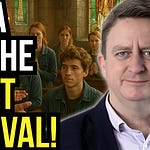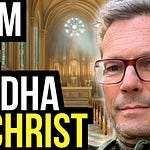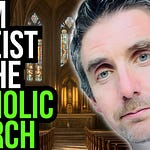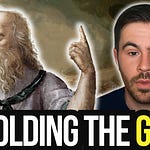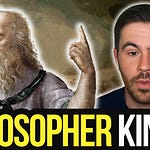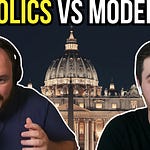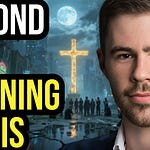Recap of the Series so far.
This is the final essay of the philosophical guide to self-development series. To recap what we’ve discussed so far, we began by looking at how the West is undergoing a crisis of meaning due to the collapse of the Aristotelian Christian worldview. We argued the Aristotelian Christian worldview collapsed because of the scientific revolution and increasingly global multiculturalism in the 21st century. We also pointed out that the dominant scientific worldview has no place for meaning, subjectivity, or consciousness. Thus modern individuals are stuck between a meaningless reductionist view of themselves as merely a ‘collection of atoms’ or an alternative decadent romanticism that denies the worldview of natural science in favour of ‘feelings’ and vague hedonic spirituality.
In essay ten, we discussed the characters of these two camps as fundamentalists and nihilists: fundamentalists who cling to outdated, low-resolution pictures of the world, and nihilists attempting to embrace and live with the chaos without creating any order. In this series, I have argued both are maladaptive responses to the collapse of the dominant worldview and that the adaptive response is actually captured in the hero meta-mythology. We spent quite a long time sketching out the general pattern of the hero meta-mythology on how one confronts chaos and makes new habitual order, and why the hero meta-mythology is a narrative description of John Vervaekes relevance realisation, so we won’t go into too much in this essay (check out these ones for a recap).
Like most of my work, this series is aimed at non-academics, particularly for people who have experienced alienation, despair, nihilism, meaninglessness and other existential issues to present an alternative and more viable interpretation of life. This aim presents challenges, and limitations on delving into ontology and the philosophical weeds, which I have realised as writing this, go deeper than I even thought. I hope in future works to lay out more clearly the proposed ontology, epistemology and ethics - as a more complete philosophy. But the importance of this series is a synthesis of philosophy and Myth for meaning-making in life.
Our interpretation of life, ourselves and our growth and development in the world has profound consequences for one’s emotional well-being, success, and satisfaction in life. Philosophy & Myth are two ways of upgrading the sophistication of one’s interpretation of life - albeit on different levels of analysis. To discuss an interpretation of life, one has to address the existential questions at the bottom of that interpretation, questions like: who are we? What is human nature? Function and identity? Who should we be? Ethical questions of virtues and vices, desirable and undesirable characteristics and ultimately, the good life? And finally, how do we go from one to another which raises questions of individual transformation? The providence of Myth and narrative, which straddles the line between generalisable stories of transformation, universal human nature, and one’s particular, individual existence. That's where the tension lies between our individual, highly contextual lives and then these broader, intergenerational generalisable patterns of successful adaptations, which we call myths. I believe it is the work of artists and philosophers to unite the two into one.
In the last three essays, we looked at Peterson’s synthesis of Rene Magritte’s ‘Son of Man’ painting as an image of the modern meaning crisis-stricken individual akin to the ‘fallen’ person in the Christian story. We discussed how this character was trapped within a narrow categorical identity and their vision blocked by the knowledge of the fruit of the tree of good and evil, with no genuine path to Transcendence. In the following essay, we argued that meaning is not an epi-phenomenon but is, in fact, the instinct that orients us to the zone of proximal development where self-transformation takes place. It is at that border of order and chaos where we experience deep meaning and where the myths and hero stories are orienting us towards zones of significant error recognition and error-correction results in deep personal transformation.
In keeping with Platonic philosophy, we argued that these personal transformations, through the cultivation of virtues, like character traits or skills, cause a general increase in wisdom which decreases self-destruction and self-deception and, therefore, illusion, connecting one to reality. In this sense, Transcendence leads to truth and reality through wisdom and meaning and is not just a psychological improvement but an epistemological improvement.
The Christian Neoplatonic worldview can have a levelled ontology, and our connection to reality is driven by our ethical development which is a powerful proposition. In this final essay, we will look at a modern path to Transcendence that can exist within a naturalistic framework based on Veraveke’s work and offer a solution to Rene Magritte’s Son of Man problem with a different perspective on the old idea of humans being made in the ‘image of God’. Then finally, we will spend some time reflecting on how a modern path to Transcendence through cultivating wisdom and meaning can shift education, culture and institutions of the future of human development.
A Modern Path to Transcendence.
In the last essay, we looked at how meta-cognition affords us Transcendence through the internalisation of other’s perspectives on our own perspective. We discussed spiritual exercises like internalising the sage in Stoicism, which uses a person of admiration as an internal model of optimal behaviour and hence affords us self-correction and transformation. Similarly, Peterson argues that hero myths are abstracted stories from the lives of admirable people like sages or heroes. We tell stories about people who lived exceptional lives and then over time, these stories are blended together to create a generalisable pattern of action that sums up a successful human life. In this way, myths also offer us portals to Transcendence by providing examples of virtue and vice which we can model ourselves on, though in a narrative and dramatic form.
We internalise the perspectives of others on our own to change our habits and patterns of seeing and these new behavioural and attentional patterns become character over time and transform the internal constraints regulating our growth and development - this is the essence of self-correction. As previously mentioned, this self-correction is not merely a psychological improvement but increases one’s ability to connect with real patterns in the world and hence has epistemological consequences. This is important because the need for a virtue tradition isn’t just ethical in some abstract sense of right and wrong but is essential for developing our ‘intellectual vision’ to see the world as we ought to see it, and has to be done through individual transformation.
The platonist levelled ontology, which is multi-levelled, involves not just deconstructing reality into its constituent parts in a reductionist manner but also observing the a priori constraints which are at play in regulating our growth and development and hence the agency we have to influence these constraints. Philosophically speaking, the ancients covered this one and didn’t fall prey to the one-sided reductionist bias of modern philosophy. The significance for the individual is that ethical transformation leads us to the truth, not just the scientific method, self-realisation connects one to reality. This philosophy, interpretation of life, justifies our connection to reality and that we can qualitatively improve our connection to reality through building wisdom and virtue tracked by meaning.
In Vervaeke’s argument for strong Transcendence, the answer to the meaning of crisis is contact with what is most real. St Augustine makes a similar argument when he says each of us has a ‘god-shaped hole’ in our hearts; the hole being ‘god-shaped’ constrains what will fill that hole and Vervaeke argues that this is a connection to what is most real. Within a Neoplatonist ontology, patterns of mind and reality overlap and therefore, the more real patterns you perceive, the more real you become, you self-realise, so, therefore, there are ontological levels which you can climb in life. The reintegration of the spiritual into the modern scientific worldview can allow us to start to afford individuals genuine Transcendence and hence the ability to transform themselves, which is deeply meaningful, and promotes agency and autonomy, which is sorely missing in the increasing complexity of the modern world.
The Image of God.
“Two things fill the mind with ever new and increasing admiration and awe the more often and steadily we reflect upon them: the starry heavens above me and the moral law within me. I do not seek or conjecture either of them as if they were veiled obscurities or extravagances beyond the horizon of my vision; I see them before me and connect them immediately with the consciousness of my existence.”
Immanuel Kant
Earlier in the series, I used Rene Magritte’s painting of The Son of Man as an example of the modern meaning crisis-stricken individual who is trapped within their categorical structure and incapable of genuine Transcendence (you read that here if you have not). Well, I consider this poorly photo-shopped image to be a solution to that problem.
Instead of the apple in front of the face blocking vision like in the Son of Man, we have a set of interlocking (what-are-mean’t to be) wedding rings - a commitment. Soren Kierkegaard describes the ethical life as a marriage of past, present and future. Similarly, Nietzsche made ‘promise-making’ the quintessential human moral activity of the ‘Sovereign Individual’ in The Genealogy of Morals. This is because a promise is to make a certain state of affairs in the future a reality and so requires genuine agency - control over the passage of time, which we often assume we have but probably do not.
The ethical individual is bound, committed - but committed to what? To a particular high-order principle?
For Nietzsche, this is freedom, but for ancient philosophers, and Christians, what is also represented by the interlocking rings as The Good: the union of logos and ontos. As Vervaeke describes, the Good is: the continually held promise of the wedding of intelligibility and reality, which we can experience as true. To describe in another language we have established already is like the commitment of Socrates and the Philosophers to ‘turning one’s soul to the Good’. An ontological and ethical commitment to the pursuit of truth, humility, and gratitude and that by some miracle is possible for human beings are connected to reality. It is a journey motivated by love to experience the loving recognition of the true, the good and the beautiful, which used to be called ‘Reason’ in philosophy.
The stars in the background are meant to communicate that the journey toward the Good is brought on by awe, wonder and admiration and in being so struck, we are called to imitate what we admire most. Motivation is no longer just a dreary bureaucratic day at the beachside but an awe-inspiring vision of the Good. It is in the heights that we look up to when we aspire, when we imagine, when we dream, that pulls us up into expanded existence - as Plato said, ‘philosophy begins in wonder’ which means ‘the love of wisdom’ begins with that wonder; love is the motivational force for the pursuit of wisdom.
Joseph Ratzinger writes that in the Catholic view, “truth” is the middle term that reconciles the authority of God and the subjectivity of conscience: the latter, when authentically free, cannot but reveal the truth established by the former (Ratzinger 1991). Unlike Nietszche, who’s ‘sovereign individual’ creates their own values, in the Catholic view, reason alone can’t create its own values, which are instilled by God into humans’ hearts, “human freedom finds its authentic and complete fulfilment precisely in the acceptance of that law of God” (John Paul II 1993: par. 35). So when practical reason is free to exercise its “participation” (John Paul II 1993: sec. 40) in the divine law, then “in the depths of his conscience, man detects a law which he does not impose upon himself, but which holds him to obedience” (Paul VI 1965: par. 16). This is a very important point, which many philosophers like St Augustine focused on as well, that through an ‘inward turn’, by getting to the bottom of one’s own being, you reached the ground of being itself, i.e God. In observing that objective within the subjective one witnessed first-hand the origin of value and that this was what was most real. In this way, we can see through the rift between the ‘starry sky above’ and ‘the moral within’ which is so present in Kant’s philosophy, despite his idealism overcompensating, and in the Cartesian splitting of object and subject is illusory. It is the presence of the beautiful, the good and the true, that point to the true nature of reality itself.
The final part of the image is the suit, which we discussed with Magritte represents a typical conservative 1950’s grey-man who wears a uniform to disappear from the world. However, this suit in the image is taken from Rene Magritte’s painting ‘The Pilgrim’ and is an attempt to dramatise the narrow market-economy identity of a mature adult into that of an awe-struck pilgrim to the Good. For Magritte, the suit represents enculturation but rather than enculturation into a mundane, stale, social-economic identity that lacks Transcendence and connection to the real. The alternative is the identity of the pilgrim-hero.
The identity of the pilgrim is integral to this new way of thinking. Jonathan Pageau explains a pilgrimage is a physical enactment of going to a holy place as a symbol for the spiritual journey of getting closer to God. The notion of life as a pilgrimage decentralises religion, as is already happening in our rapidly de-institutionalising world, and provides a meta-identity that can scaffold the individual hero’s journeys that we take part in. The pilgrim identity highlights the throughline to an individual life that can join together the often disparate and irreconcilable moments that have no continuous narrative order - which is the norm for a modern meaning crisis individual.
This is because in the west we have lost the throughline to our lives which is God. I encountered this problem very recently in my own life while trying to compose an autobiographical account of the first thirty years of my life. Where do you start? Generally, you’ll generally start with memories, but soon that becomes muddled, because why these memories and not others? And if you put them in chronological order, they will bore the pants off you and make no sense? It’s just a meaningless jumble of events that happened to you? What connects these incidents in life together into a meaningful whole?
One quickly realises that to write an account of your life, you need a throughline to organise the whole of the disparate events - and the question is: what is the proper throughline? Is my life all about being Irish? Is it about being a man? Is it about technology and the modern world? Or drinking? I boiled over this for quite some time. But what was apparent was that whatever I chose the story to be about, would be the highest organising principle for my life and hence the lens through which I saw myself and so held tremendous power. And really what is the highest good? What is the most significant value? And the traditional answer is God, absolute value, and so it became apparent to me that there was a need for an organising principle, a throughline, to create narrative order across time, to make one’s life coherent, and that only the highest value could fill that spot, and thus I was beginning my non-consensual journey to becoming a Christian. If you ever sit down and try and create a narrative order for your life, you will realise that you need a throughline and not any throughline will do, and perhaps then you will be in the same situation I was - needing the God, which you have rejected and insulted for so long.
I would suggest, rather boldly, that this poorly-photo-shopped photo is meant to be a symbol of the ‘image of god’, the image which human beings are made in and which gives us transcendent value. In Maps of Meaning, Peterson describes the hero as the ‘Son of God;
“Behind every particular (that is historical) adventurer, explorer, creator, revolutionary and peacemaker lurks the image of the “son of god,” who sets his impeccable character against tyranny and the unknown”. This image is a symbolic representation of the pattern of action that categorises the hero, the abstracted and generalised pattern of successful adaption. So there’s a peculiar tripartite nature to this image, in that it’s our origin, who we really are and what makes us uniquely human, our destiny, a destination in reunion with that image in which we are made which is a kind of self-actualisation, and hence that suggests the journey between - and so the whole thing is more like a story, a meta-narrative, which is like the self itself - not a static individual identity, but more like a metaphor for life.
Approaching A Modern Meta-Narrative.
“Thought through my eyes. Signatures of all things I am here to read, seaspawn and seawrack, the nearing tide, that rusty boot. Snotgreen, bluesilver, rust: coloured signs. Limits of the diaphane. But he adds: in bodies. Then he was aware of them bodies before of them coloured. How? By knocking his sconce against them, sure. Go easy. Bald he was and a millionaire, maestro di color che sanno. Limit of the diaphane in. Why in? Diaphane, adiaphane. If you can put your five fingers through it, it is a gate, if not a door. Shut your eyes and see.”
James Joyce.
In the beginning of this series, we started talking about attention and that:
“Morality begins in paying attention to what you don't want to pay attention to but should attend too”.
Perhaps we have gone the long way round to return to such a simple truth, but this is necessary because that is the point of the hero’s journey. The hero’s journey is a series of deaths and rebirths, transformative learning experiences, which let go of vices, illusions, dreams and moral imperfections ‘to see as one ought to see’. The Platonic philosophers and alchemists really understood that we must not look but close our eyes and replace the faculty of vision for another, what is called the beatific vision. The ultimate goal of the quest is a better form of vision; the point of death and rebirth of transformation, updating one’s attentional value hierarchy is that it allows us to see what was once hidden right before our eyes.
As Plotinus writes - No eye that has not become like the sun will see the sun, nor will anyone who is not beautiful see the beautiful. In keeping with Aristotle’s conformity theory of knowledge, we know by becoming. So we must become like the sun to see the sun, become like the beautiful to see the beautiful. The three transcendentals: the true, the good and the beautiful, point to God’s nature, the nature of ultimate reality; God is the throughline - not present in particular but organising everything we see. As the Upanishads say, ‘God is not an object of sight but that by which we see’. Like what we discussed with Plotinus and the sculpture, the sculpture has a vision of beauty and good and truth and then works to make the marble and the vision one. The same is true here of the work of self-development and self-realisation, we attain the vision and work to become like the one, and the suggestion is that because we are made in the image of the one. It is not only our natural conclusion but an ethical call to adventure which we must partake in.
That is why this journey must be begun by faith. What is begun by faith, ends in vision, and so a good-faith commitment is needed first to get on the road. Faith takes us on the road, but the destination, understanding and vision, are what give meaning and value to the journey. Understanding is intellectual vision - seeing God clearly with the mind’s eye is the goal and meaning of faith. Spiritual life is about training the intellectual vision to see what it cannot see yet. The word ‘contemplation’ comes from a temple, which actually comes from the Latin word for a part of the sky that you look up to to see the signs from the gods; to contemplate is to look up towards the divine. Beauty calls us forward on a transcendent journey to encounter the Good, and the product of this adventure is truth which is a better form of vision, a better self.
In summary, the image of God as our fundamental identity is shockingly egalitarian for the time, and suggests not just our origin but also our destination, a destiny, a journey in between, an awe-struck pilgrimage to the Good. The pilgrimage is everywhere now; we are all spiritual pilgrims looking for our spiritual home. I have represented the image of God (crudely) in the above image, because I think it sums up the philosophy of self-development or, probably more accurately, self-realisation, which I have been exploring, which isn’t just a static belief system but, in fact, a dynamic and meaningful spiritual way of life. A journey that is begun with faith, a faith that leads to a better vision, and a better vision is a better self.
In Conclusion.
This series was, in many ways, doomed to difficulty from the start. I quickly realised that each arena I skipped through was a book or an entire field of study! So I hope to make up what is missing in accuracy with generalising well. We are in a time that requires integrating science and spirituality, mind and body, and being able to to start seeing the union beyond the irreconcilable opposites. In my own way, I’ve tried to shed some light on that emerging worldview that puts meaning and wisdom rightfully at the centre of human concerns.
There are many levels to the death of God and the meaning crisis, and thus, there are just as many levels to the rebirth. What seems foolish and half-baked today hopefully heralds a better future. But if this worldview is correct, there will be no saving grace; we damned, forsaken, fallen, and our atonement requires sacrifice, moral courage, wisdom, heroism, a rediscovery of those lost values which sound so sentimental to the cynical and nihilistic modern world. There’s nothing easy about any of this. There will need to be a revolution in arts and culture, education and the academy, the internet and our own hearts, new institutions and reinventions of old ones focused on wisdom and meaning. The advent of Artificial intelligence and persuasive technology have brought a definitive end to human unconsciousness, and we must know ourselves in order to survive.
There has never been a more serious bottleneck than in the next hundred years, and our individual thoughts and actions will be magnified to unprecedented importance - that’s the good and bad news. So the work of the arts, humanities, and philosophy is to ‘turn our souls to the Good’ and to help us see as we ought to see. This is a treacherous journey we must embark on, but Peterson argues the great hero’s journey of our lives is ethical and that taking responsibility for that journey is the source of meaning, and somehow, that all starts with your attention, with what we value—so having said that, what should you be paying attention to that you are not?
(PS Taking the usual break over August so will be back with more podcasts and essays in September).







